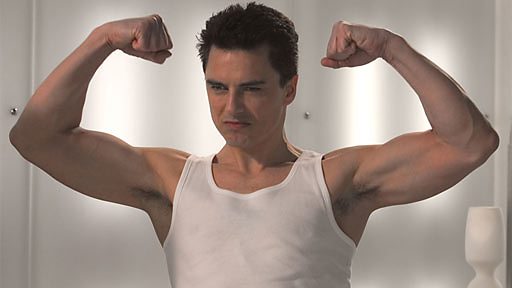I just need some more wood for lower shelves, instead of putting the cloth on the floor. It's the perfect height for drafting, and not too hard to sit on.
Anyway, after the research from the last post I decided to make the vest from buff broadcloth, with a red polished cotton back and lining, and ties to cinch it in back. I used the "Single-breasted roll-collar waistcoat, 1830s-1840s" draft from R.I. Davis' Men's Garments 1830-1900.
This broadcloth is pretty fabulous. I ordered it from Burnley & Trowbridge. Here it is after using the iron to shape it. You can see that the cloth doesn't want to lie flat, and in fact has quite a bit of volume now that I've shrunk and stretched various edges:
The back pieces, in red polished cotton (ordered from Payless Fabric). The back pattern piece is cut in two double pieces, for the inside and outside backs.
I used the front piece as a template to cut the canvas for the fronts. In this case since the broadcloth is already pretty heavy I used cotton muslin for the canvas, cut on the bias.
The pockets are done in the same way as I've done before.
Here I've added the collar extension, basted in the canvas, and basted in the edge tape. The tape for the collar roll line is basted in tight, to help keep the collar against the chest. The bottom edge is turned up, and creates its own facing to attach the lining to.
The edge of the button extension turned over and cross stitched to the canvas.
Now I discover a problem. This broadcloth is thick. It's about 1/16" thick on its own. Fold that over, and add a folded over facing, and I'm looking at a front edge that's 1/4" thick! I was worried that this might happen (but not worried enough that I took steps to fix it ahead of time). Enter the beauty of broadcloth - because it's tightly-woven and then felted, you can use a raw edge and not worry about it fraying. This was actually common with period clothing, and I've seen examples of this in person (I don't have any photos though).
I cut off the turn-over of the button extension, and trimmed 1/4" (the seam allowances) off the collar and facing edges. This isn't too pretty where I've already stitched on the edge tape, but I'm not going to take it off. This edge will be underneath the buttoned-up front so I'm not worried about catching a glimpse of the canvas. The buttonhole-side I hadn't done yet, so I trimmed the canvas back before I stitched on the edge tape for that piece.
I basted the facing in place. In the front where it buttons, the facing is just behind the front, and then shifts to be just ahead of the undercollar. Does that make sense? That way, the pieces that will be showing are overlapping the pieces that won't.
After felling the facing in place you can see how it wants to lie - it's not flat. This will (hopefully) form around my chest and neck.
Success! After felling the total thickness of the front edge is just over 1/16".



























